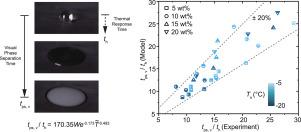Interfacial dynamics of NaCl solution droplets impact on cold surfaces: spreading and salt-induced phase transition
IF 5
2区 工程技术
Q1 ENGINEERING, MECHANICAL
International Journal of Thermal Sciences
Pub Date : 2025-10-11
DOI:10.1016/j.ijthermalsci.2025.110375
引用次数: 0
Abstract
Understanding the interfacial behavior of saline droplets impacting cold surfaces is critical for a wide range of thermal, environmental, and crystallization-related applications. This study experimentally investigates the spreading and phase separation dynamics of NaCl solution droplets on temperature-controlled hydrophilic silicon surfaces. Using a custom-built platform with high-speed imaging, we captured the full evolution of droplet morphology, including inertial spreading, salt-induced phase separation, and final solidification. The influences of impact height, surface temperature, and salt concentration were systematically investigated. A modified empirical correlation for the maximum spreading factor was developed based on hydrophilic surface conditions, while retaining the theoretical Weber number scaling while adjusting fitting parameters to reflect salinity-induced changes in viscosity and surface tension. Building on this, a thermal response time model was adapted to account for the influence of concentration-dependent thermal diffusivity and freezing point depression. By introducing a dimensionless temperature parameter, an empirical correlation was proposed to predict the visual phase separation time as a function of both inertial and thermal effects. This unified framework shows strong agreement with experimental data across a broad range of conditions. The findings provide new insights into multicomponent droplet impact behavior and offer predictive tools for engineering systems involving freeze desalination, anti-icing coatings, and phase-controlled thermal microfluidics.

NaCl溶液液滴冲击冷表面的界面动力学:扩散和盐致相变
了解盐滴撞击冷表面的界面行为对于广泛的热、环境和结晶相关应用至关重要。实验研究了NaCl溶液液滴在温度控制的亲水硅表面上的扩散和相分离动力学。利用定制的高速成像平台,我们捕捉到了液滴形态的完整演变,包括惯性扩散、盐诱导相分离和最终凝固。系统地考察了撞击高度、表面温度和盐浓度等因素的影响。在保留理论韦伯数标度的同时,调整拟合参数以反映盐度引起的粘度和表面张力变化,基于亲水表面条件建立了修正的最大扩展因子的经验相关性。在此基础上,采用了热响应时间模型来考虑与浓度相关的热扩散率和凝固点下降的影响。通过引入无量纲温度参数,提出了一种经验相关性来预测视相分离时间作为惯性和热效应的函数。这一统一的框架与广泛条件下的实验数据显示出强烈的一致性。这些发现为多组分液滴撞击行为提供了新的见解,并为涉及冷冻脱盐、防冰涂层和相控热微流体的工程系统提供了预测工具。
本文章由计算机程序翻译,如有差异,请以英文原文为准。
求助全文
约1分钟内获得全文
求助全文
来源期刊

International Journal of Thermal Sciences
工程技术-工程:机械
CiteScore
8.10
自引率
11.10%
发文量
531
审稿时长
55 days
期刊介绍:
The International Journal of Thermal Sciences is a journal devoted to the publication of fundamental studies on the physics of transfer processes in general, with an emphasis on thermal aspects and also applied research on various processes, energy systems and the environment. Articles are published in English and French, and are subject to peer review.
The fundamental subjects considered within the scope of the journal are:
* Heat and relevant mass transfer at all scales (nano, micro and macro) and in all types of material (heterogeneous, composites, biological,...) and fluid flow
* Forced, natural or mixed convection in reactive or non-reactive media
* Single or multi–phase fluid flow with or without phase change
* Near–and far–field radiative heat transfer
* Combined modes of heat transfer in complex systems (for example, plasmas, biological, geological,...)
* Multiscale modelling
The applied research topics include:
* Heat exchangers, heat pipes, cooling processes
* Transport phenomena taking place in industrial processes (chemical, food and agricultural, metallurgical, space and aeronautical, automobile industries)
* Nano–and micro–technology for energy, space, biosystems and devices
* Heat transport analysis in advanced systems
* Impact of energy–related processes on environment, and emerging energy systems
The study of thermophysical properties of materials and fluids, thermal measurement techniques, inverse methods, and the developments of experimental methods are within the scope of the International Journal of Thermal Sciences which also covers the modelling, and numerical methods applied to thermal transfer.
 求助内容:
求助内容: 应助结果提醒方式:
应助结果提醒方式:


